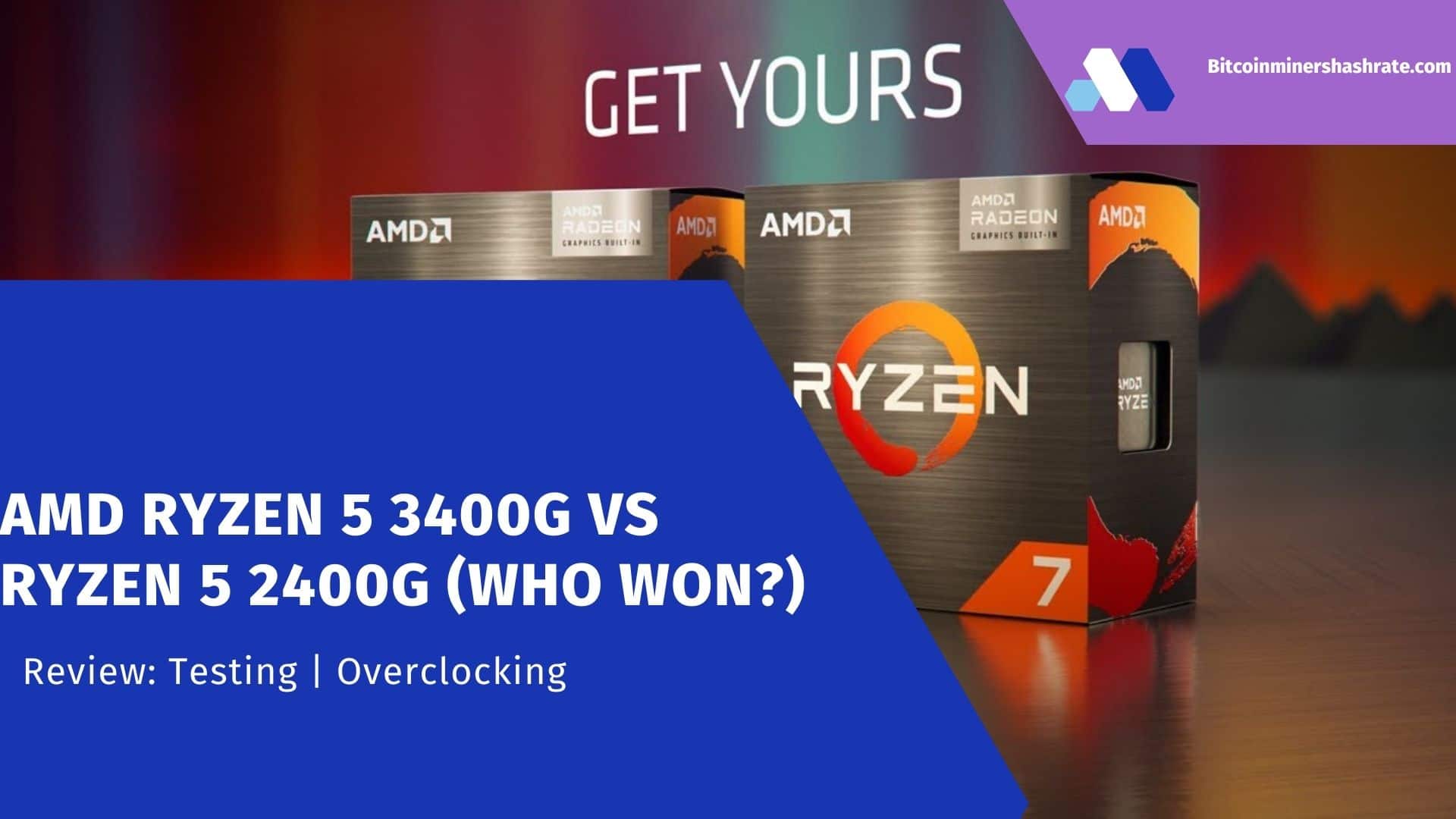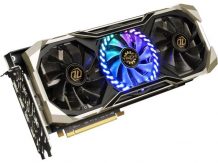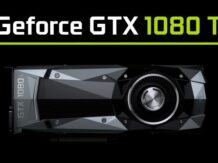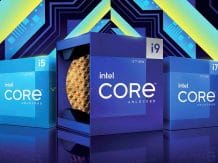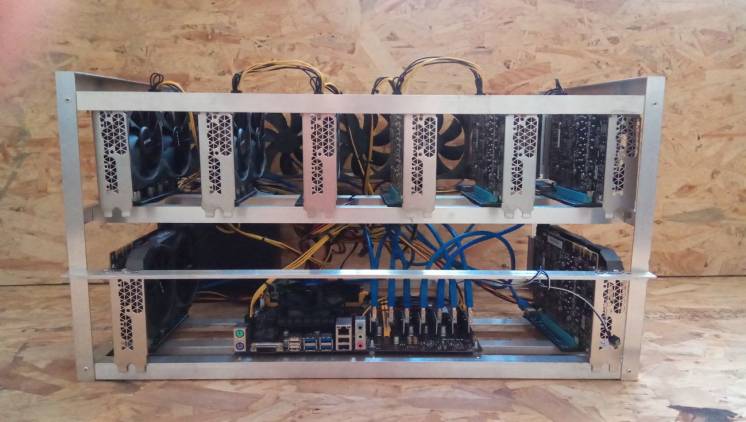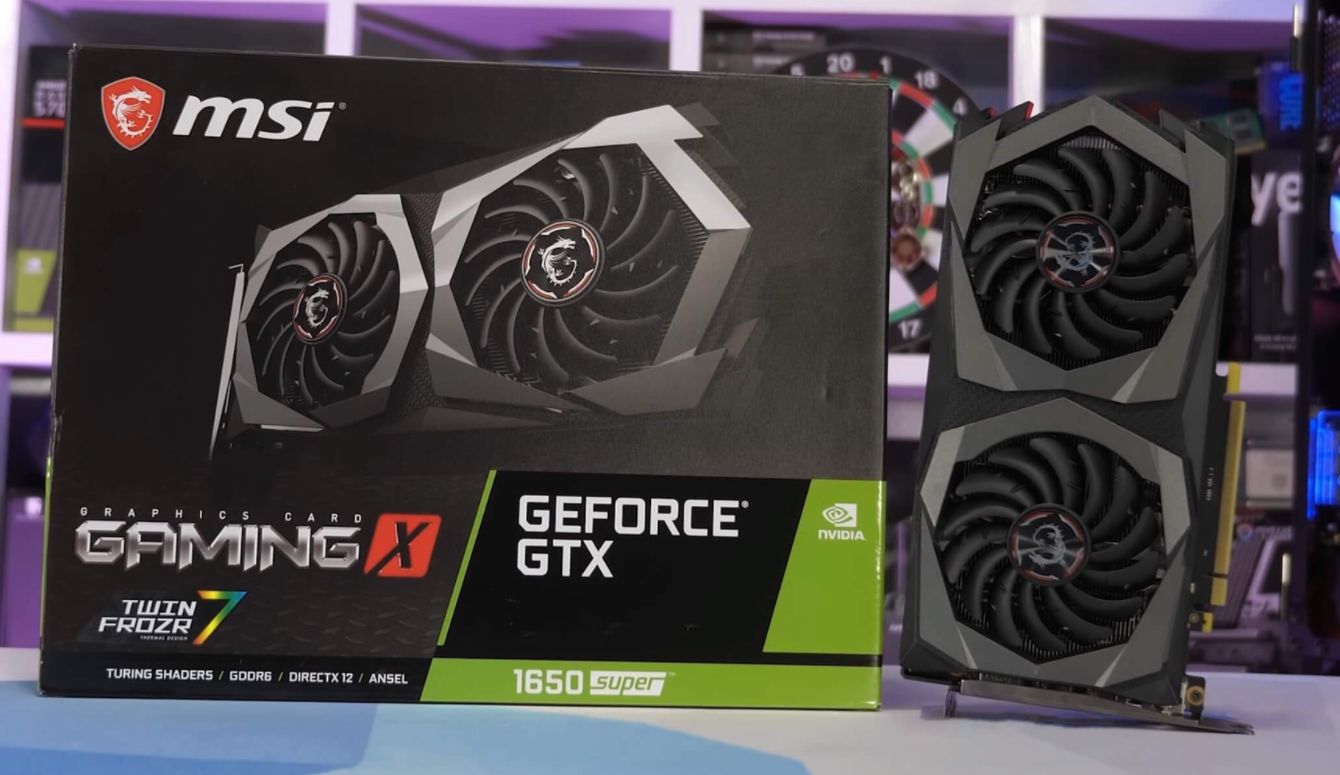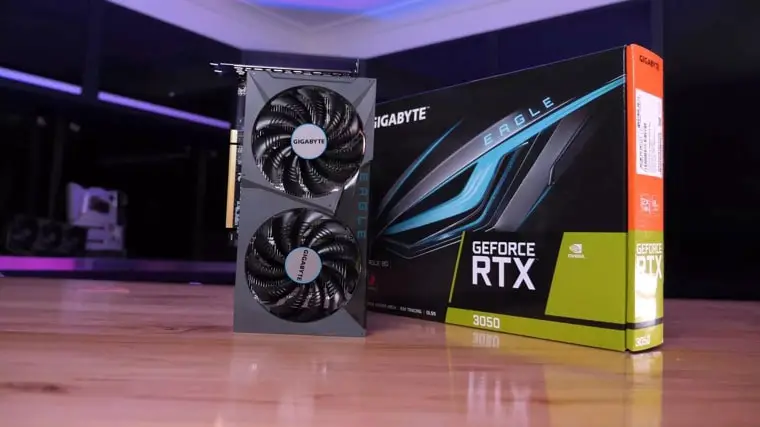AMD Ryzen 5 3400G VS Ryzen 5 2400G Processors Comparison: Testing/ Benchmark/ Overclocking/ Pros & Cons (Advantages and Disadvantages) -New AMD processor with the best integrated graphics on the market. What kind of performance will the Ryzen 5 3000 series offer? Comparison of AMD APUs of different generations.
The Ryzen 5 3400G is technically the third generation of AMD’s new processors, but it doesn’t boast the new 7nm process technology or larger L3 cache. Let’s analyze its strengths and weaknesses in comparison with its predecessor – 2400G.
MD Ryzen 5 3400G and Ryzen 5 2400G Processors: Specifications
| Parameter | Ryzen 5 2400G | Ryzen 5 3400G |
| Number of CPU cores | 4 | 4 |
| Number of threads | 8 | 8 |
| base frequency | 3.6 GHz | 3.7 GHz |
| Max. frequency | Up to 3.9 GHz | Up to 4.2 GHz |
| L1 cache size | 384 KB | 384 KB |
| L2 cache size | 2 MB | 2 MB |
| L3 cache size | 4 MB | 4 MB |
| Number of GPU cores | 11 | 11 |
| GPU frequency | 1250 MHz | 1400 MHz |
| TDP nominal / TDP | 65W | 65W |
| PCI Express Version | PCIe 3.0 x8 | PCIe 3.0 x8 |
| Technical process | 14nm FinFET | 12nm FinFET |
The processors under study are representatives of slightly modified versions of the Zen and Zen+ architectures and have corresponding differences. The 3400G is made using a thinner process technology and boasts increased core clock speeds. The essential difference is the presence of solder under the heat-distributing cover in 3400G, rather than a plastic thermal interface, as in 2400G, which should have a positive effect on temperatures in the load.
It is worth noting that both processors cannot use the PCIe 3.0 x16 bus mode when working with a discrete video card. This fact does not greatly affect the performance of modern video accelerators, but you should not forget about it.
AMD Ryzen 5 3400G Vs Ryzen 5 2400G – Testing methodology and stands
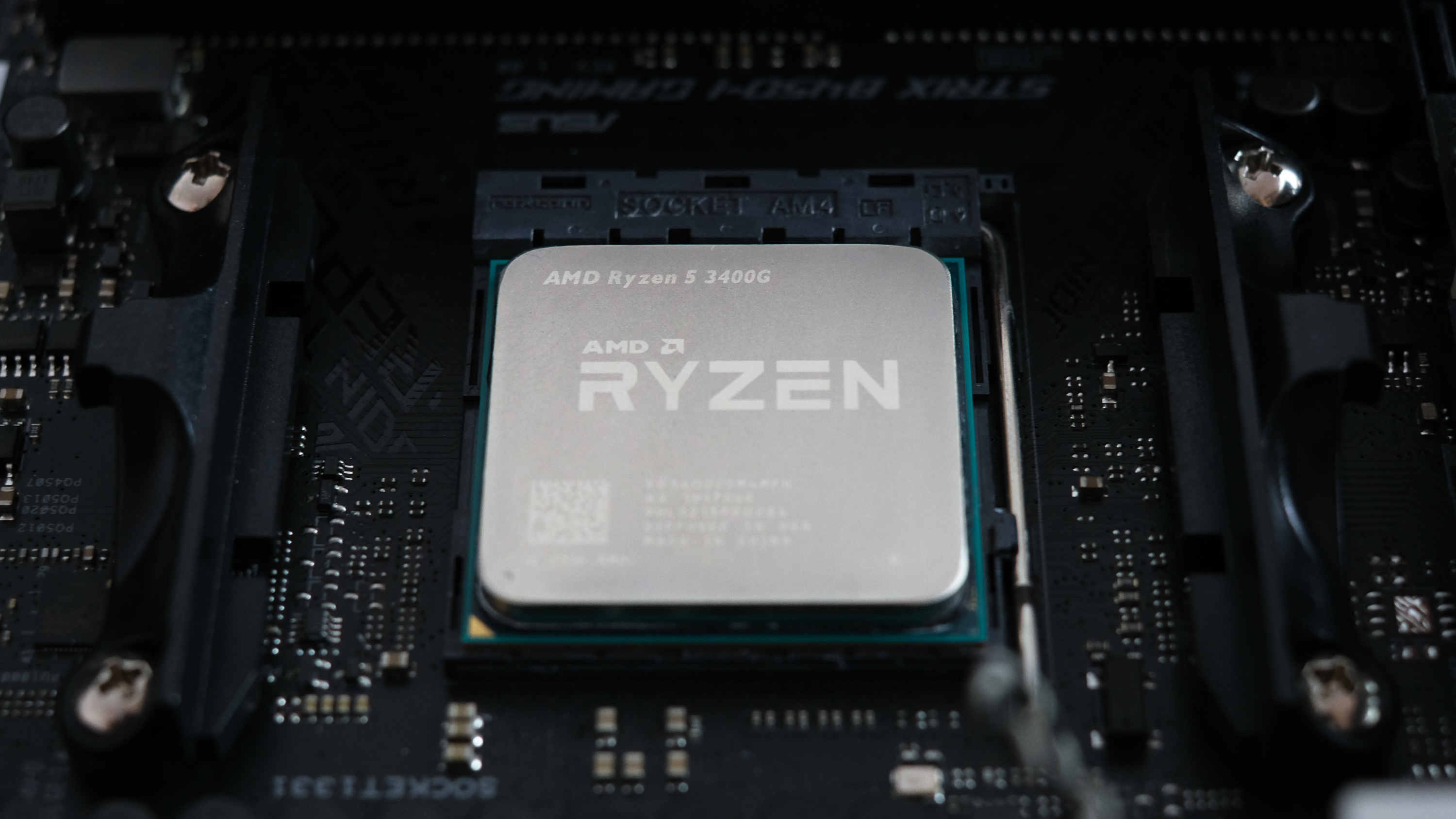
In addition to the two processors under study, the following components were used:
- Motherboard: ASUS ROG Crosshair VI Hero for tests with a discrete graphics card
- Motherboard: ASUS ROG Strix B450-I Gaming for integrated Vega 11 tests
- Video card: Palit GeForce GTX 1080 Ti GameRock Premium Edition
- ОЗУ: G.Skill Trident Z 2×8 ГБ (F4-3600C15D-16GTZ)
- Cooling: liquid cooling for tests with a discrete graphics card
- Cooling: AMD Wraith Prism, bundled cooler for Ryzen 9 3900X
- SSD: Kingston A400 120 GB (Windows 10 Pro with all updates, test programs)
- BP: Corsair RM850i 850W
- Housing: Thermaltake Core P5
The default operating modes of processors are the most interesting, most users will use the APU in this way, but overclocking opportunities cannot be ignored. As a reasonable limit, we set the voltage to 1.35V; for compact PCs with their not the most productive cooling systems, higher values \u200b\u200bwill be unjustified.
The Ryzen 5 2400G is absolutely stable at 3900 MHz, you can still play games at frequencies higher, but heavier tasks can already cause errors. Not the most outstanding result, without overclocking in multithreading, the frequency of all cores stays around 3800 MHz, in low-threaded tasks individual cores reach 3900 MHz. The built-in video card was made to work at 1400 MHz without noticeable problems, equaling this parameter with the new 3400G.
For the Ryzen 5 3400G, the maximum value turned out to be 4100 MHz while maintaining absolute stability, it was not possible to reach the declared boost value for all cores, without overclocking the frequencies stay around the 4000 MHz mark, in a low-threaded load individual cores reach 4200 MHz. Vega 11 allowed to set the frequency to 1560 MHz.
The RAM is tuned for maximum performance. For tests of processors with a discrete video card, the memory worked at a frequency of 3533 MHz, with an integrated video card, a frequency of 3200 MHz, closer to real use, was used with the same timings.
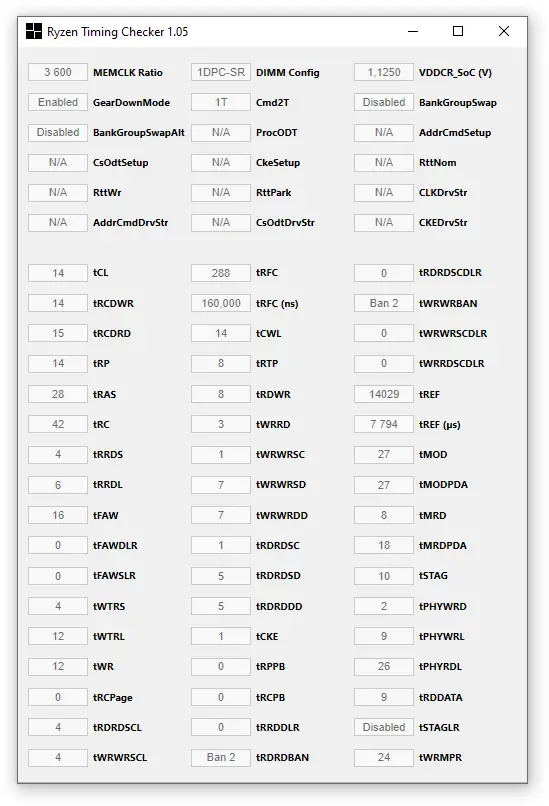
The tests were repeated many times, the results were averaged, with insufficient repeatability, the number of runs increased, the minimum and maximum results were discarded.
Processor performance
The following configurations were used with their symbols on the diagrams:
- 2400G def: default CPU settings, Vega 11 frequency – 1250 MHz, RAM frequency – 3200 MHz for Vega 11 and 3533 MHz for tests with GTX 1080 Ti
- 2400G 3.9GHz: 3.9GHz All Core, 1400MHz Vega 11, 3200MHz RAM for Vega 11 and 3533MHz for GTX 1080 Ti benchmarks
- 3400G 3.9GHz: 3.9GHz all-core, 1400MHz Vega 11, 3200MHz RAM for Vega 11 and 3533MHz for GTX 1080 Ti benchmarks
- 3400G def: default CPU settings, Vega 11 frequency – 1400 MHz, RAM frequency – 3200 MHz for Vega 11 and 3533 MHz for tests with GTX 1080 Ti
- 3400G 4.1GHz: 4.1GHz all-core, 1560MHz Vega 11, 3200MHz RAM for Vega 11 and 3533MHz for GTX 1080 Ti benchmarks
In addition to the out-of-the-box modes, the 3400G 3.9 GHz and 2400G 3.9 GHz variants are interesting for comparing internal changes in the processor architecture in equal conditions.
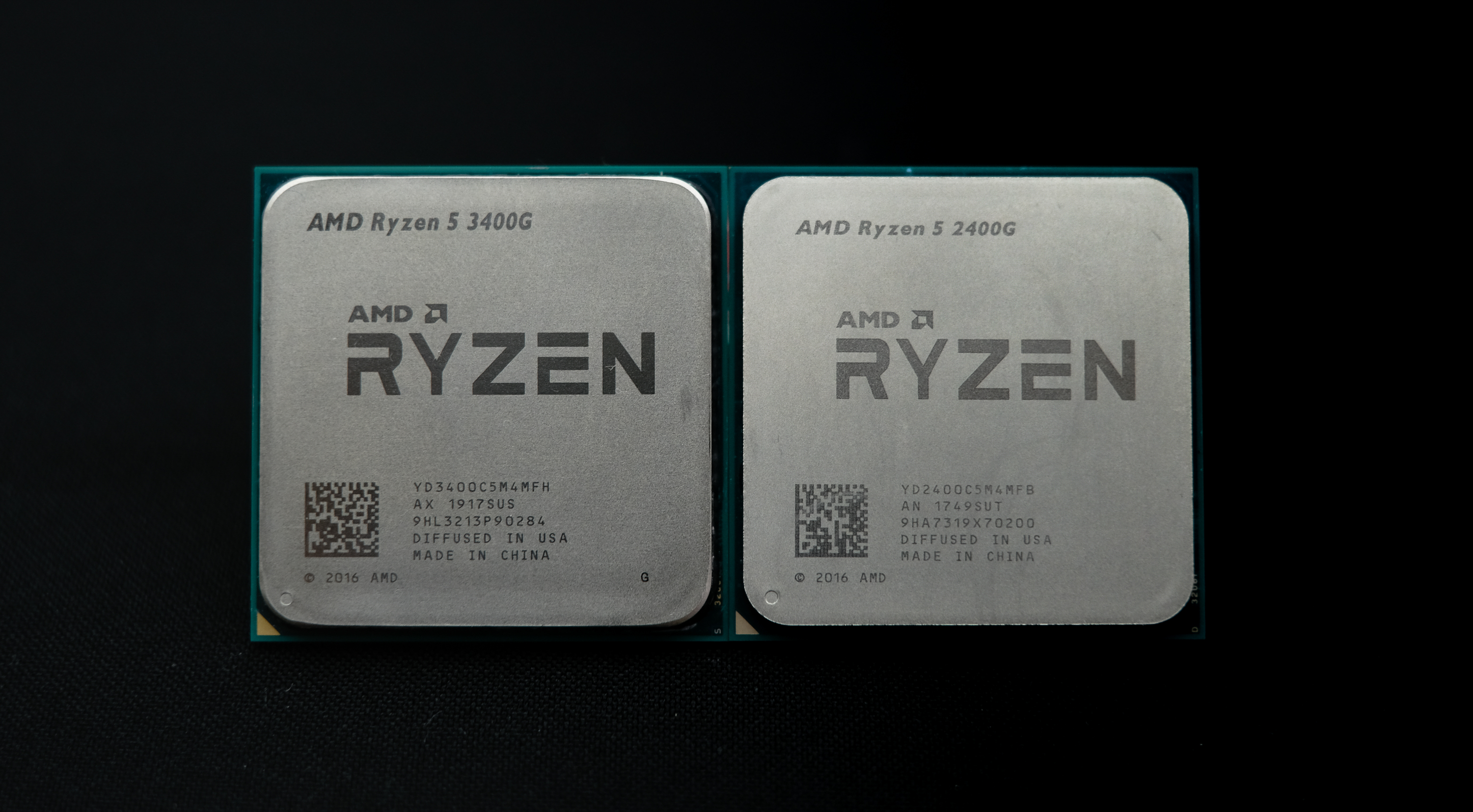
Cinebench R20
A popular test package that gives an idea of the speed of rendering 3d scenes by the processor.
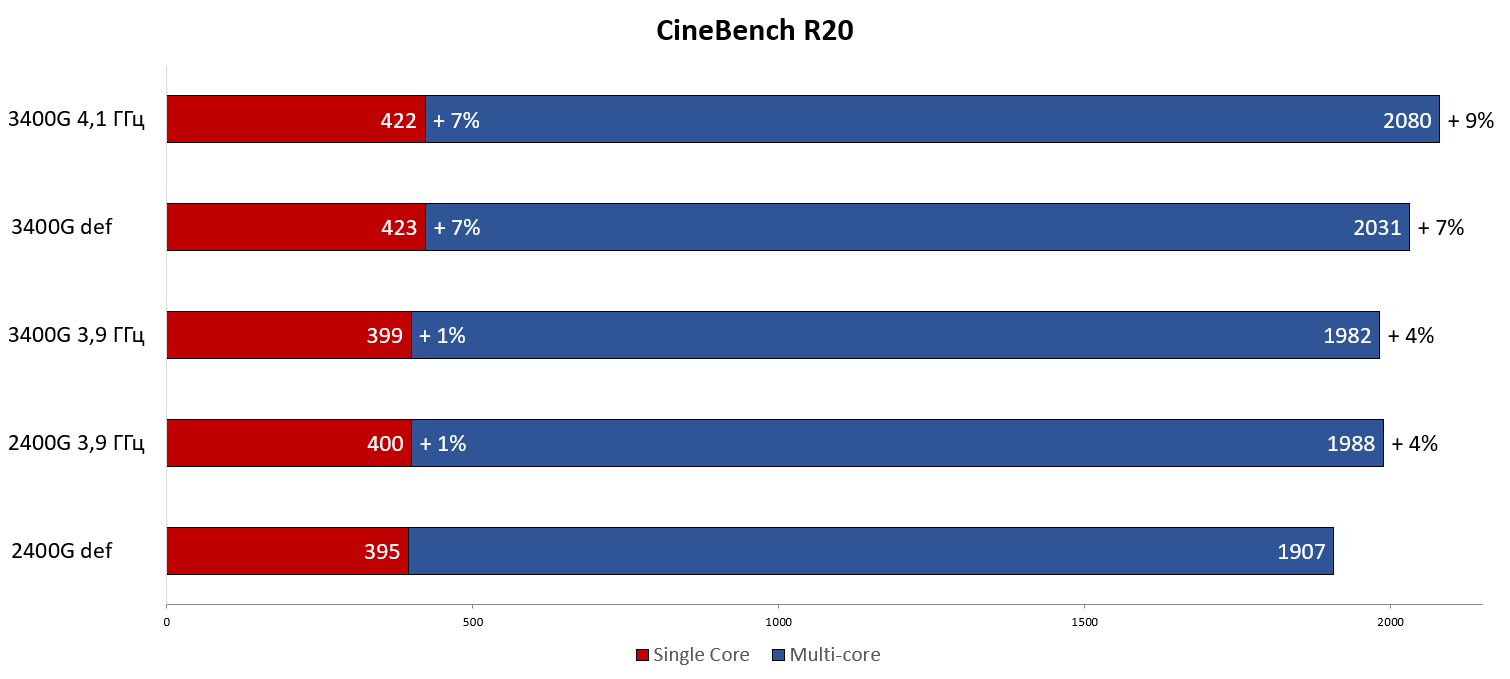
Expected result, processor performance is identical at the same frequency. Overclocking is practically pointless, especially for the 3400G. Both test subjects show high results for quad-core solutions. The advantage of the new generation processor in the default mode is primarily due to the difference in the frequencies of the cores.
Cinebench R15
Still an up-to-date version, the result in it is useful for comparison with earlier processor reviews.
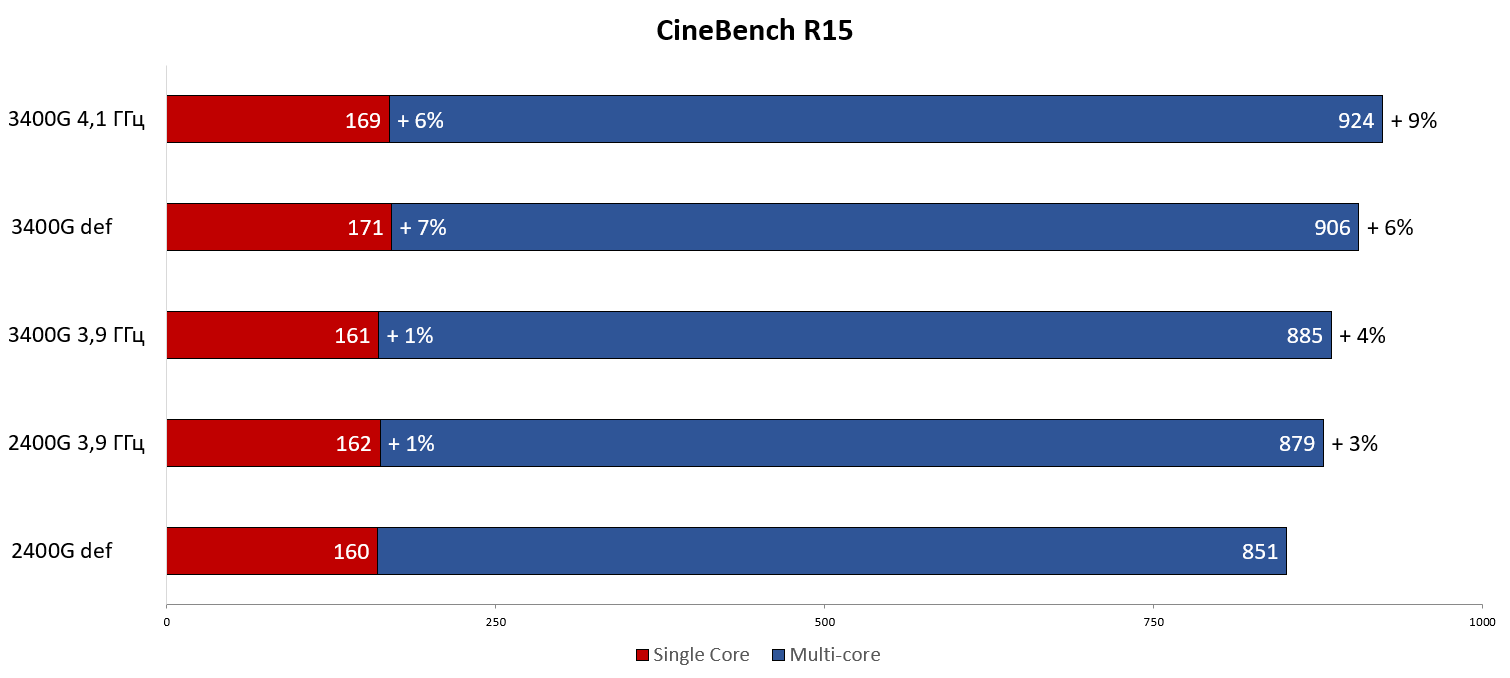
The situation is similar to the previous test, the results are very close, overclocking is justified only in the presence of excess cooling and the desire to take advantage of this opportunity, the practical results will not change much. At the same frequency, 2400G and 3400G show exactly the same performance.
7-Zip
The built-in benchmark makes great use of the CPU’s multi-threaded capabilities when archiving data.
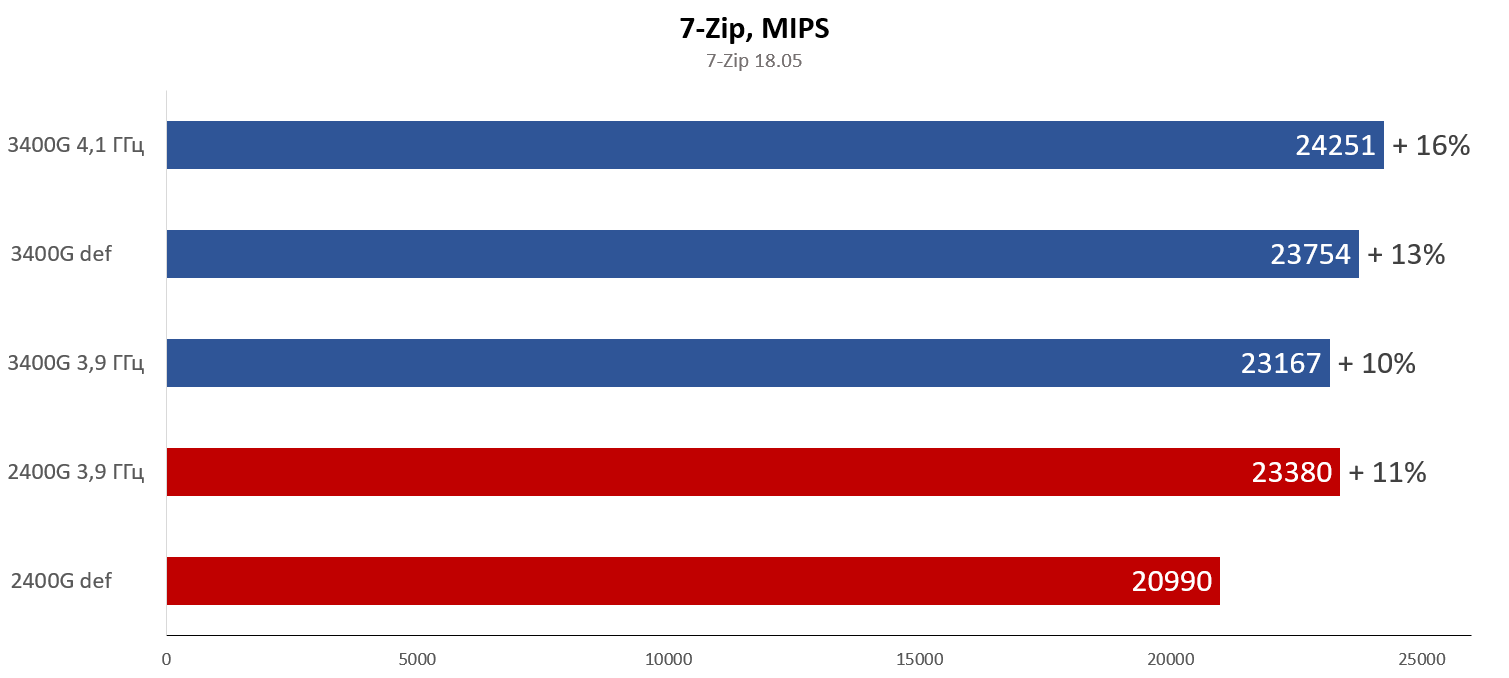
By fixing the frequency value at 3.9 GHz, the 2400G gets eleven extra percent to the result, the 3400G at this frequency shows the same numbers in the test. The advantages of the novelty in frequency allow you to achieve better results.
Aida Memory benchmark
It is no less interesting to find out if there is a difference in working with RAM between representatives of different generations, processors were tested at the same frequency and with completely identical RAM settings.
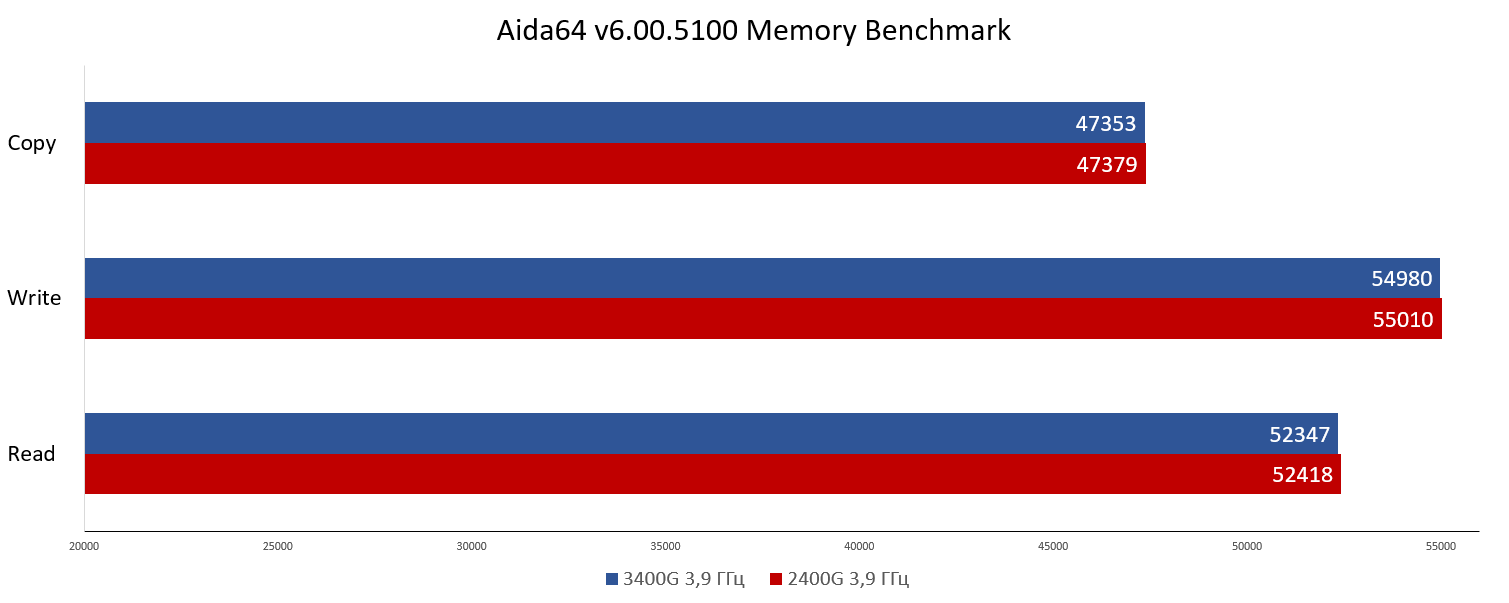
It was not possible to identify differences.

Here, too, full parity, the promised improvements in working with memory mainly include the optimization of automatically set settings, but if you use manually set ones, the difference tends to zero.
GeekBench 4
A test suite that emulates a real load in various applied tasks.
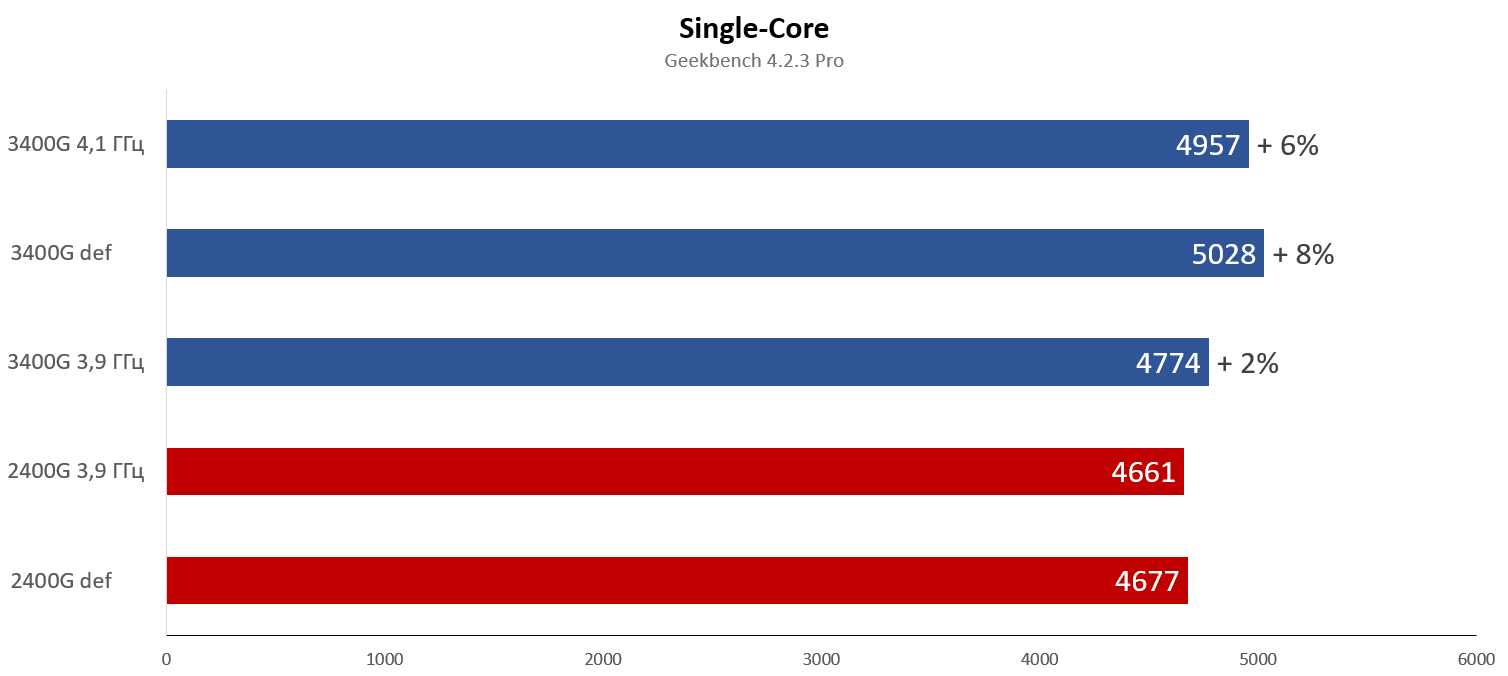
The higher boost rate in low-threaded tasks allowed the 3400G with default settings to bypass the fixed frequency mode across all cores in this test.
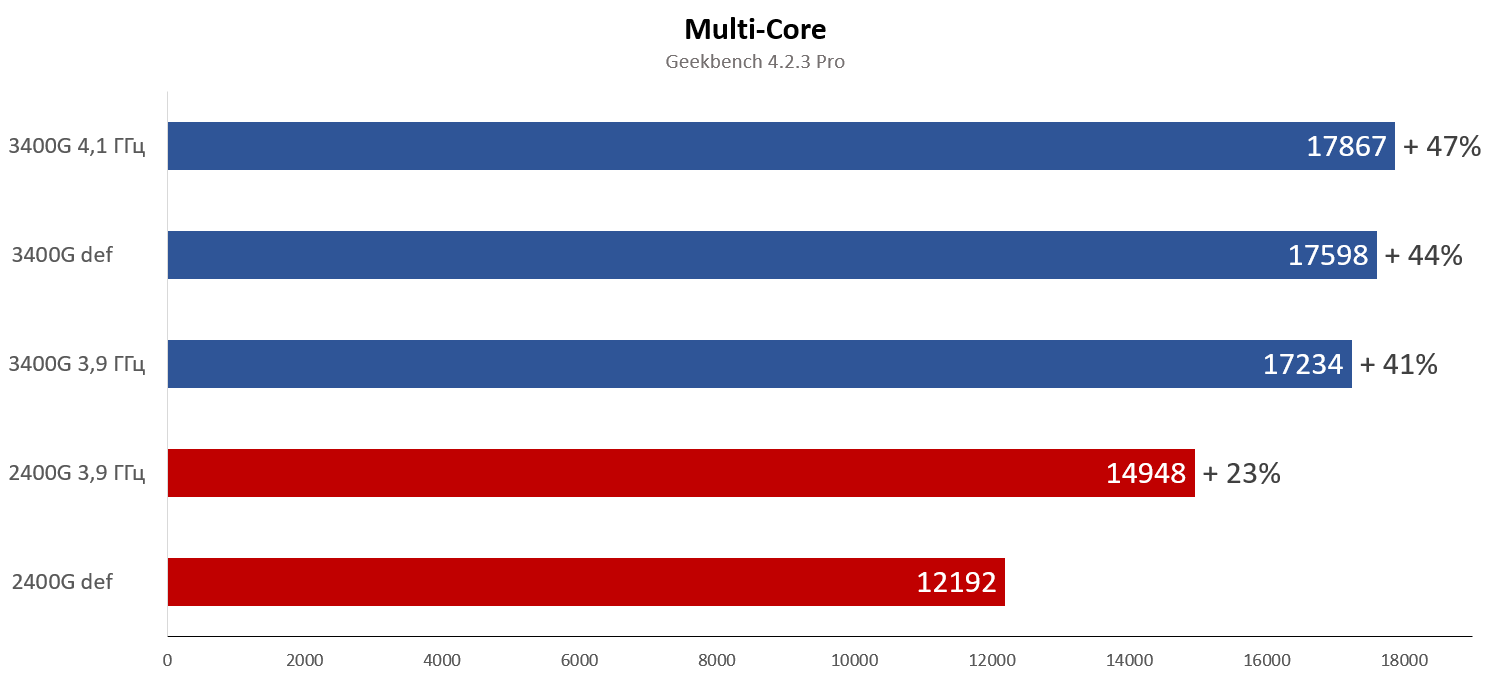
An interesting result, at the same frequency the 3400G outperforms its predecessor by more than 15%, the situation does not correlate with previous tests, let’s try to figure it out. Let’s compare more detailed transcripts of the test, in addition to absolutely identical results, there are several very different ones:
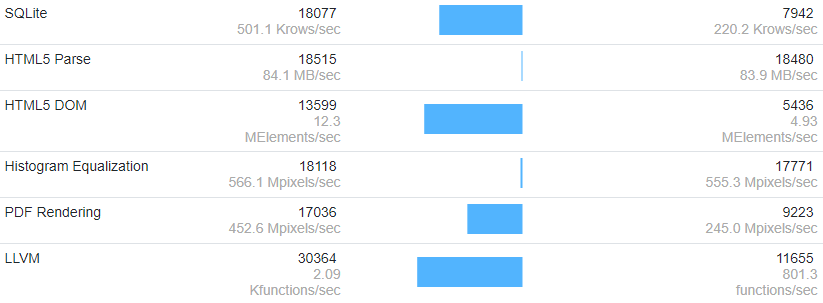
When checked in the benchmark database, the results of similar systems are a similar situation. It is possible that the test package uses different instructions to perform tasks, but we were not able to fully find out the cause of this misunderstanding. When using GeekBench on Mac OS X and Linux operating systems, the 2400G performance in these tasks is comparable to the 3400G. Other comprehensive tests do not reveal any significant difference at the same core frequency.
Temperature regime
The presence of solder in the 3400G is a big plus in building quiet systems, we will compare the heating of the cores at the same operating mode of the processors – 3900 MHz and a voltage of 1.35 V. An AMD Wraith Prism cooler was used for cooling.

After 10 minutes of the Aida 64 stress test, the temperature of the 3400G reached 65° and stabilized at this point, for the 2400G under similar conditions, the temperature of the cores stepped over 70°. In real conditions of use, the difference will be expressed in slightly higher revolutions of the cooling system fans, and therefore higher noise from them. During gaming tests, temperatures differed slightly.
Gaming tests with a discrete graphics card
It is impossible to avoid comparing gaming performance, so first let’s exclude the built-in video card factor and conduct a test with minimal influence of the video subsystem on the result.
Far Cry 5
- Resolution: 1440p
- Graphics quality: maximum
- Resolution scale: 0.5
- Built-in test
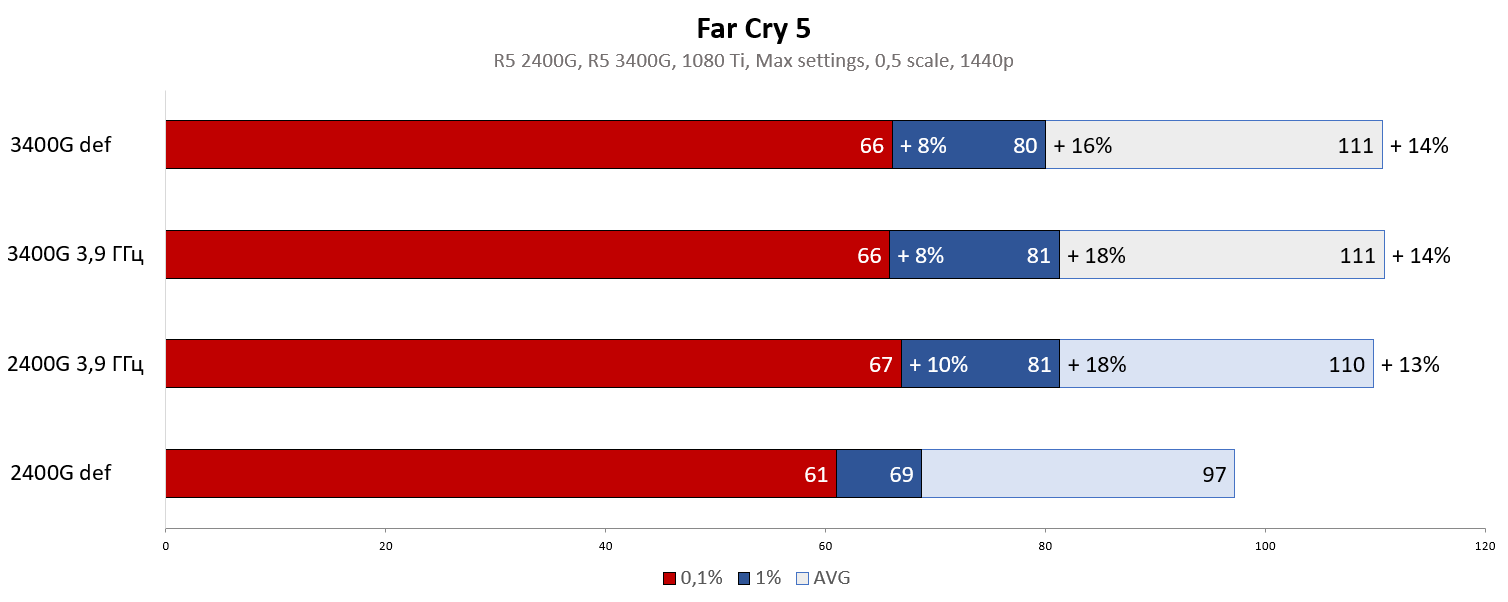
Very comfortable fps values, only 2400G gets a noticeable difference from the mode of use, overclocking to 3900 MHz allows you to catch up with 3400G.
PlayerUnknown’s Battlegrounds
- Resolution: 720p
- Graphics quality: very low
A segment with a landing on the roof of the school was chosen, there are active hostilities. Do not be surprised at the meaning of rare and very rare events – the moment is very difficult for any processor.
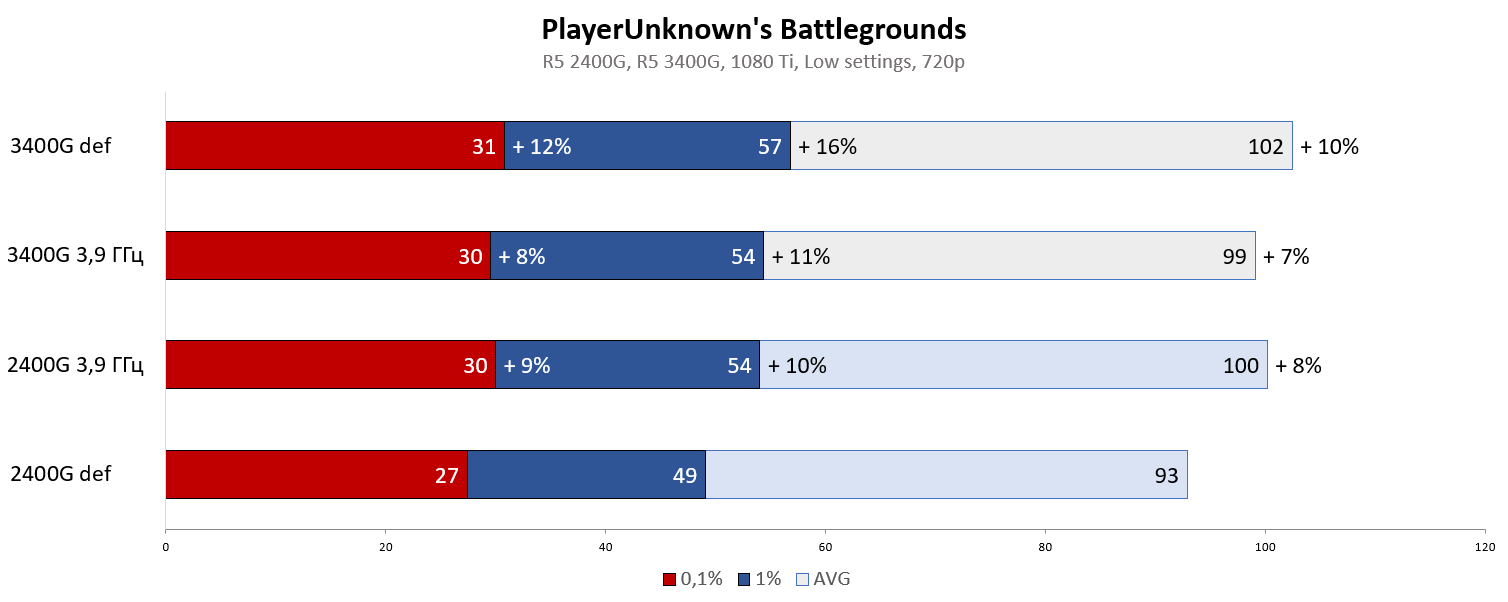
Almost parity again, slightly behind the 2400G in out of the box mode, but the boost in clock speeds almost compares the result with the 3400G
Assassin’s Creed Origins
- Resolution: 720p
- Graphic quality: the highest
- Permission modifier: 50%
- Built-in test
To minimize the dependence of the result on the video card, anti-aliasing is set to “low”.
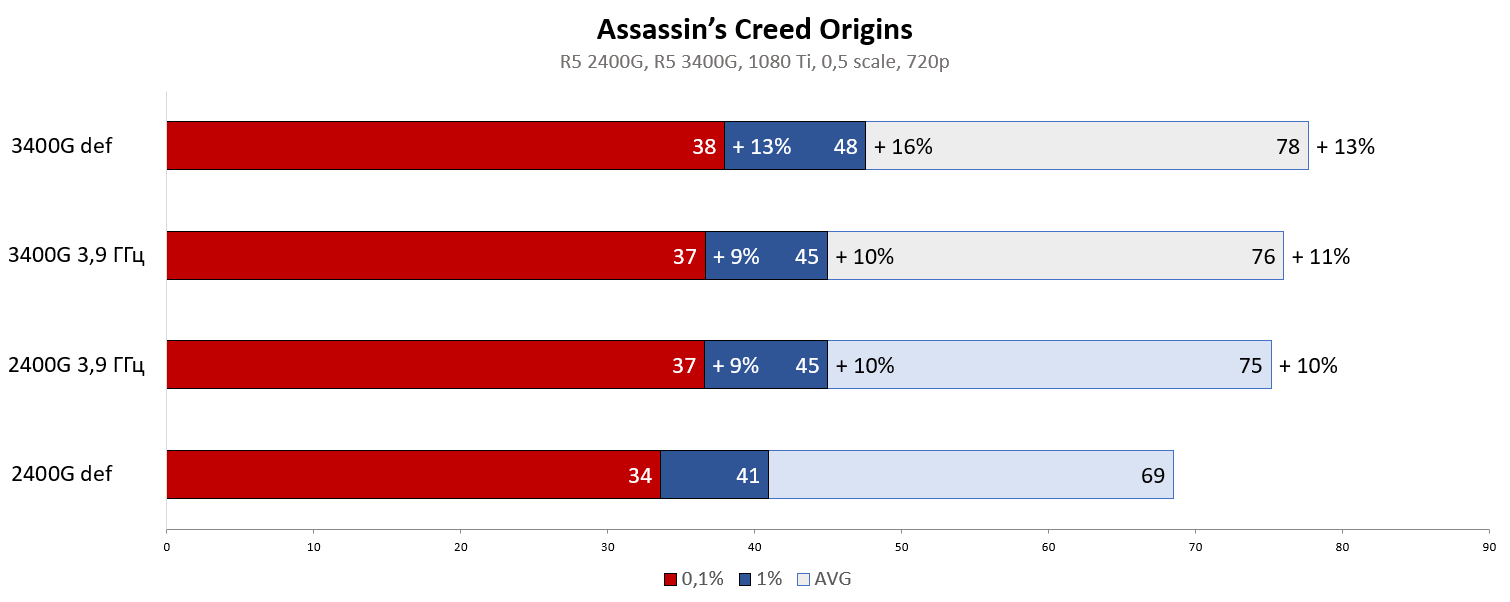
No surprises, at close frequencies – a close result.
Shadow of the Tomb Raider Demo
- DX 12
- Resolution: 720p
- Configuration: maximum
- Anti-Aliasing: Disabled
- Built-in test, third cut
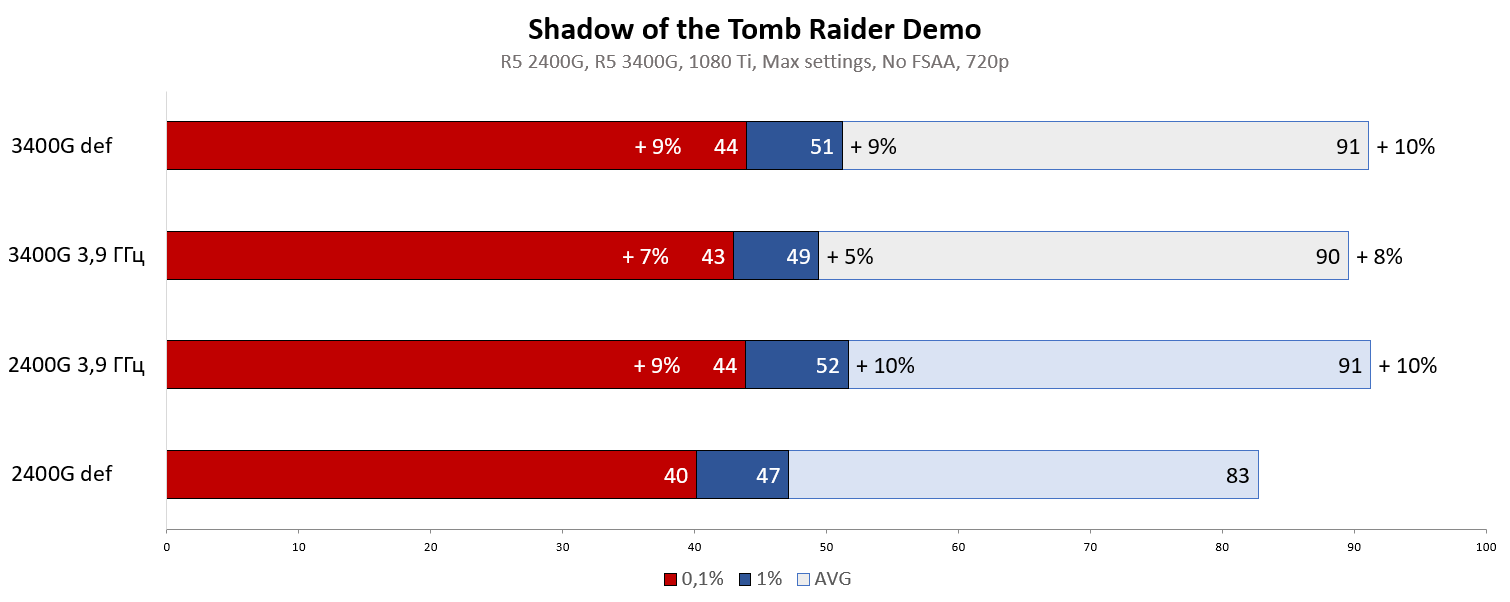
And this game is no exception, the extra megahertz helps 2400G reach the level of novelty.
Vega 11 integrated graphics test
As the basis of a compact media PC for the living room, both processors fit perfectly: playing video files, decoding an online stream and other similar tasks, the Ryzen 5 APUs handle effortlessly. Of main interest are the capabilities of Vega 11 in modern 3D games. Please note that in order to detect the difference, we had to build charts not from zero and enter tenths for FPS values.
Far Cry 5
- Resolution: 1080p
- Graphics Quality: Low
- Resolution scale: 0.8
- Built-in test
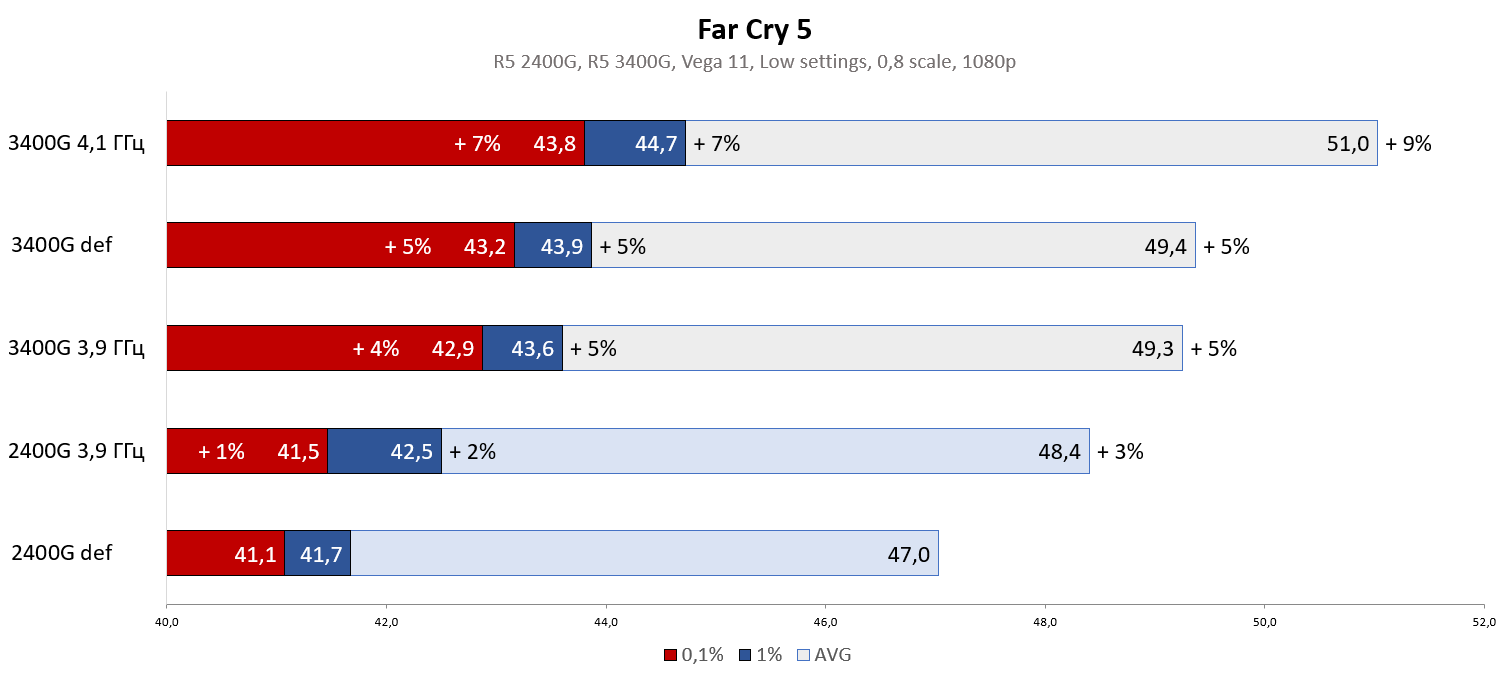
Not the best repeatability made it possible to accumulate a microscopic difference when the processors operate under the same conditions, it would not be critical to call it critical, but it is noticeable on the diagram. In general, the built-in video card will allow you to play even in FullHD with a slight nuance – you will have to reduce the render scale, which will slightly reduce the final resolution. It is not so easy to identify the difference in the picture by eye, but the increase in FPS is noticeable. If you use a lower resolution, you can even raise the graphics settings. The gameplay is quite tolerable and you can enjoy the story.
PlayerUnknown’s Battlegrounds
- Resolution: 1080p
- Graphics quality: very low
The same stretch with landing and action as in the test with the GTX 1080 Ti. The graphics quality settings are the most esports, increased sharpness is enabled.
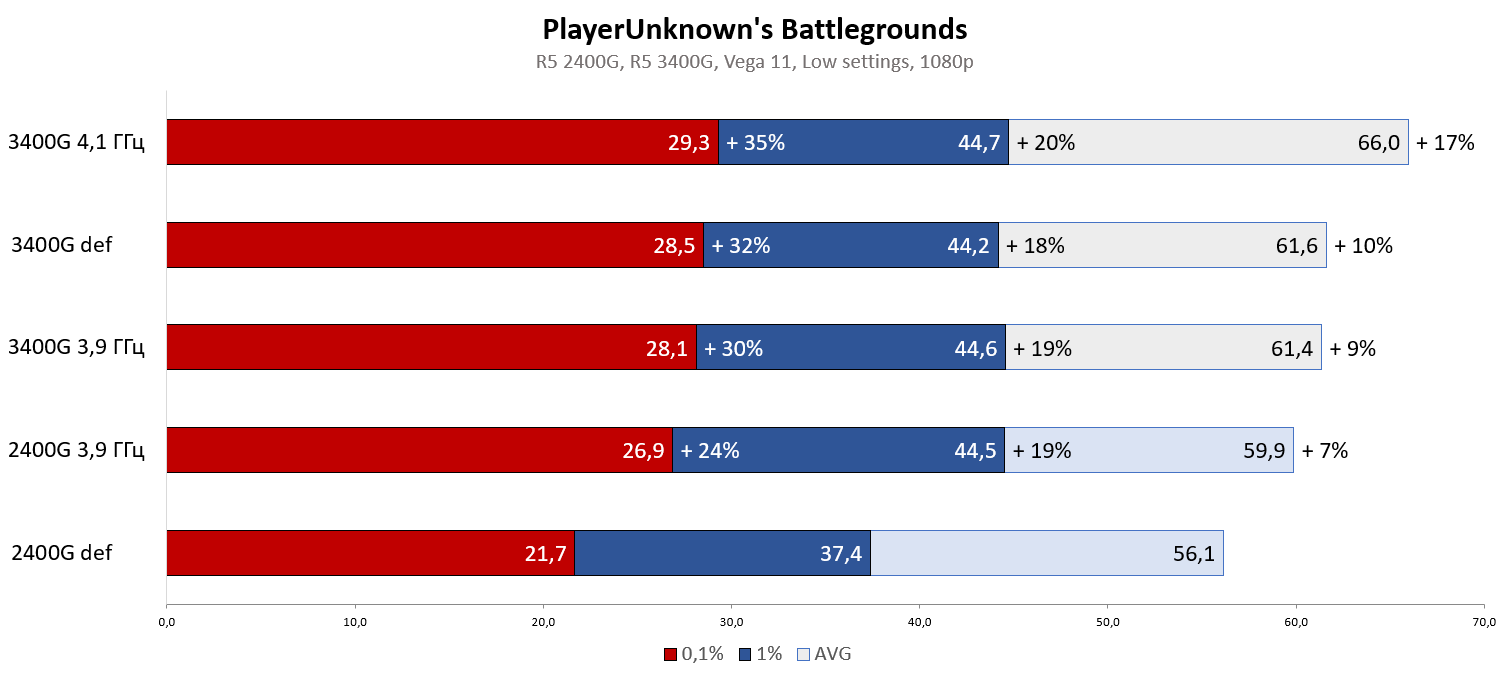
The high complexity of the landing scene and the starting battle of a large number of players leaves an imprint on the result. Of course, don’t expect a sustained 144fps from an integrated graphics card in a game that many gamers have upgraded in the recent past due to optimization issues.
Assassin’s Creed Origins
- Resolution: 1080p
- Graphics quality: very low
- Built-in test
Only low settings allowed us to get an acceptable result, for 1080p I had to reduce the resolution modifier to 80%.
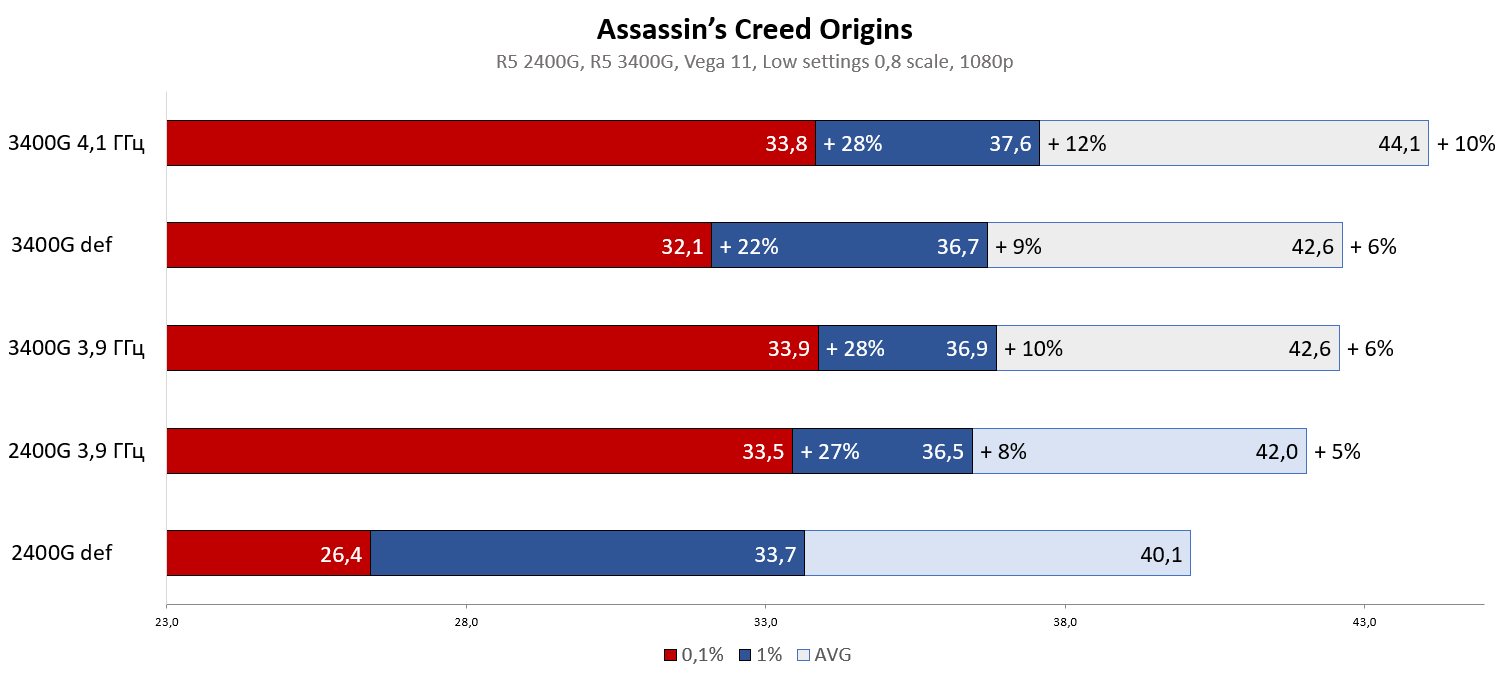
Quite a console gaming experience, AAA project, poor performance. Watching adventures in ancient Egypt on the TV screen with a gamepad in hand is quite comfortable. Overclocking the video core gives a noticeable boost to the Ryzen 2400G.
Counter-Strike: Global Offensive
The detail of models and textures is left at a high level, FXAA anti-aliasing and anisotropic filtering are enabled, the rest of the settings are set to medium. A popular card with a built-in benchmark turned out to be beyond the power of Vega 11, smoke grenades drop the performance very much, this does not happen outside the test. To get the result, we used a deathmatch game with bots, several segments lasting 5 minutes showed outstanding repeatability.
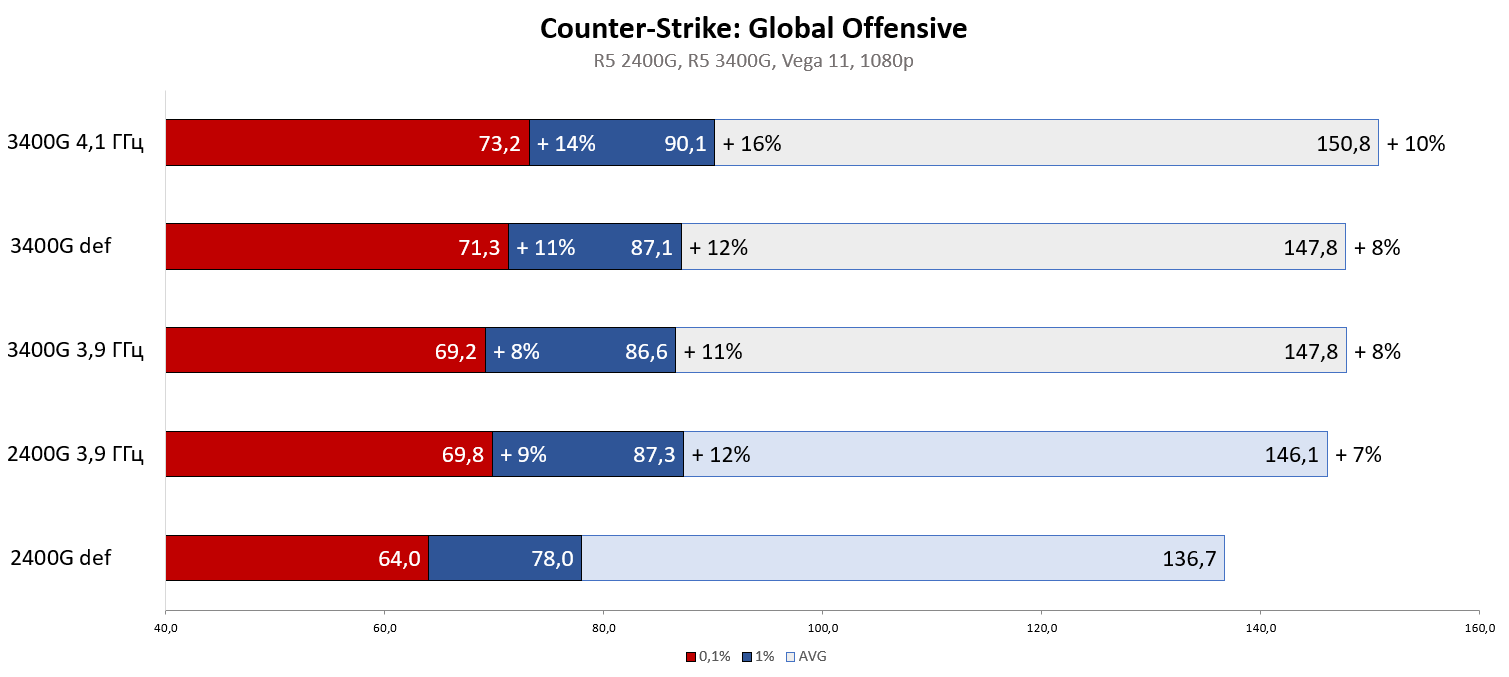
This project made me forget that integrated graphics are used, excellent performance will not make you regret having a high-hertz monitor. Smooth gameplay, 2400G lag without FPS monitoring is absolutely not noticeable.
Conclusion
Processors with the fastest integrated graphics on the market haven’t worked wonders and won’t make you ditch discrete graphics cards, but they can make a great base for a media PC in the living room, a powerful office workstation, or an undemanding gamer’s compact PC. AMD’s APUs are more than enough power for any media content and for non-resource-intensive workloads.
Integrated graphics Vega 11 will comfortably play modern competitive online games like Counter-Strike: Global Offensive, Dota2, World of Tanks. Definitely, all the games of the recent past will not cause problems either, not to mention the classics of the gaming industry. Such processors can become the basis of a “computer for study”, and the child will not be very upset by the capabilities of the built-in video card. Support for FreeSync technology will smooth out the impression of not the highest FPS level in heavy AAA game projects.
Overclocking capabilities for both processors are modest. If you want to achieve a significant increase in performance, the user will inevitably face difficulties in maintaining system stability: simultaneous overclocking of the video core, RAM and the processor cores themselves is a very delicate process. A slight increase in operating frequencies, as in this comparative review, does not give a significant increase in results, but is fully justified with excessive cooling.
The Ryzen 5 3400G does not show a significant advantage over its predecessor, but it would be foolish to refuse solder or slightly higher frequencies for the same price. Advantages and disadvantages will be common for 2400G and 3400G.
Advantages
- High performance 8 threads
- High performance integrated graphics
- Support for FreeSync technology
- Modest cooling requirements
- Affordable cost




